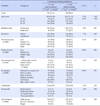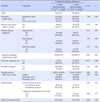Abstract
Purpose
This study examined the characteristics differences associated with 1-year continuous smoking abstinence in Korean young adult and middle-aged male workers.
Methods
'Korea National Health and Nutrition Examination Survey (KNHANES)' is an ongoing surveillance system that assesses the health and nutritional status of Koreans. For a secondary analysis of cross-sectional data from KNHANES VI-1, this study selected 683 Korean male workers as a subpopulation, who were young adult or middle-aged. The subpopulation was composed of success or failure group of 1-year continuous smoking abstinence. Binomial logistic regression analysis was performed.
Results
Success group was more likely to be older, live in urban areas, rate their health status as excellent or good, and have ever been diagnosed with hypertension than failure group. Additionally, Success group was less likely to have used electronic cigarettes (e-cigarettes), drink more than once a month, and have been exposed to secondhand smoking in workplace within a week.
Figures and Tables
Table 1
Comparisons of General Characteristics between Sucess and Failure Group in Continuous Smoking Abstinence (N=683)

Table 2
Comparisons of Health related Characteristics between Sucess and Failure Group in Continuous Smoking Abstinence (N=683)†

Table 3
Comparisons of Social and Environmental Characteristics between Sucess and Failure Group in Continuous Smoking Abstinence (N=683)†

Table 4
Factors related to 1-year Continuous Smoking Abstinence in Young Adult and Middle-aged Male Workers (N=679)†

References
1. Ministry of Health and Welfare. Manual for integrated health promotion program 2015: Tobacco cessation [Internet]. Sejong: Ministry of Health and Welfare;2015. cited 2015 December 16. Available from: http://www.mohw.go.kr/front_new/jb/sjb030301vw.jsp.
2. Choi JS. The effect of early detection of hypertension and diabetes on smoking and alcohol drinking. Health Soc Welf Rev. 2007; 27(1):103–130. 10.15709/hswr.2007.27.1.103.
3. Korea Centers for Disease Control and Prevention. Trends of smoking prevalence: Gender, over 19years old [Internet]. Daejeon: Statistics Korea;2015. cited 2015 May 27. Available from: http://kosis.kr/statHtml/statHtml.do?orgId=117&tblId=DT_11702_N001&vw_cd=MT_ZTITLE&list_id=117_11702_A01_011&seqNo=&lang_mode=ko&language=kor&obj_var_id=&itm_id=&conn_path=E1.
4. Korea Centers for Disease Control and Prevention. Analysis guideline for the sixth Korean national health and nutrition examination survey (KNHANES VI-1) [Internet]. Cheongju: Ministry of Health and Welfare;2015. cited 2015 October 12. Available from: https://knhanes.cdc.go.kr/knhanes/index.do.
5. Lindström M, Isacsson SO, Elmstahl S. Impact of different aspects of social participation and social capital on smoking cessation among daily smokers: A longitudinal study. Tob Control. 2003; 12(3):274–281. 10.1136/tc.12.3.274.
6. Twyman L, Bonevski B, Paul C, Bryant J. Perceived barriers to smoking cessation in selected vulnerable groups: A systematic review of the qualitative and quantitative literature. BMJ Open. 2014; 4(12):e006414. 10.1136/bmjopen-2014-006414.

7. Statistics Korea. Attempt to stop smoking and reasons for failure within 1-year (over 20 years old) [Internet]. Daejeon: Statistics Korea;2014. cited 2015 December 29. Available from: http://kosis.kr/statHtml/statHtml.do?orgId=101&tblId=DT_1SS14HE042R&vw_cd=MT_ZTITLE&list_id=D215_2014&seqNo=&lang_mode=ko&language=kor&obj_var_id=&itm_id=&conn_path=E1.
8. Pender N, Murdaugh C, Parsons MA. Health promotion in nursing practice. 6th ed. Upper Saddle River, NJ: Pearson Education;2011. p. 349.
9. Choi HS, Sohn HS, Kim YH, Lee MJ. Factors associated with failure in the continuity of smoking cessation among 6 month's smoking cessation successes in the smoking cessation clinic of public health center. J Korean Acad-Ind Cooperation Soc. 2012; 13(10):4653–4659. 10.5762/kais.2012.13.10.4653.
10. Ha MH, Lee DH. Predictors of quitting smoking - results of worksite smoking cessation campaign of a steel manufacturing industry. Korean J Occup Environmen Med. 2000; 12(2):70–178.
11. Kim JS, Yu JO, Kim MS. Factors contributing to the intention to quit smoking in community-dwelling elderly smokers. J Korean Acad Community Health Nurs. 2012; 23(4):358–365. 10.12799/jkachn.2012.23.4.358.

12. Ryu SY, Shin JH, Kang MG, Park J. Factors associated with intention to quit smoking among male smokers in 13 communities in Honam region of Korea: 2010 community health survey. Korean J Health Educ Promot. 2011; 28(2):75–85.
13. Song TM, Lee JY, Cho KS. The factor influencing on success of quitting smoking in new enrollees and re-enrollees in smoking cessation clinics. Korean J Health Educ Promot. 2008; 25(2):19–30.
14. Statistics Korea. The employment on inhabited areas, sex, age, education [Internet]. Daejeon: Statistics Korea;2015. cited 2016 March 20. Available from: http://kosis.kr/statHtml/statHtml.do?orgId=101&tblId=DT_1ES3B04&conn_path=I2.
15. Hyun HS, Lee IS. Body mass index (BMI) -related factors of community-dwelling elders: Comparison between early and late elderly people. J Korean Acad Community Health Nurs. 2013; 24(1):62–73. 10.12799/jkachn.2013.24.1.62.
16. Korea Centers for Disease Control and Prevention. Publication list [Internet]. Cheongju: Ministry of Health and Welfare;2015. cited 2015 December 29. Available from: https://knhanes.cdc.go.kr/knhanes/index.do.
17. Kim SY. Adult's health behaviors according to their stages for the success of smoking cessation [master's thesis]. Seoul: Sahmyook University;2008. 107.
18. Korea Centers for Disease Control and Prevention. The sixth Korea national health and nutrition examination survey (KNHANES VI-1), 2013 [Internet]. Cheongju: Korea Centers for Disease Control and Prevention;2013. cited 2015 October 12. Available from: https://knhanes.cdc.go.kr/knhanes/index.do.
19. Lichtenstein E. The smoking problem: A behavioral perspective. J Consult Clin Psychol. 1982; 50(6):804–819. 10.1037/0022-006x.50.6.804.

20. Fiore MC, Novontny TE, Pierce JP, Giovino GA, Hatzindreu EJ, Newcomb PA, et al. Methods used to quit smoking in the United States: Do cessation programs help? JAMA. 1990; 263(20):2760–2765. 10.1001/jama.263.20.2760.

21. Ministry of Employment and Labor. Act on prohibition of age discrimination in employment and aged employment promotion [Internet]. Sejong: Korea Ministry of Government Legislation;2013. cited 2015 December 30. Available from: http://www.law.go.kr/eng/engLsSc.do?menuId=1&query=employment+age&x=0&y=0#EJP19:0.
22. Korea Labor Institute. Statistics on mandatory retirement systems of companies [Internet]. Daejeon: Statistics Korea;2014. cited 2015 December 30. Available from: http://kosis.kr/statHtml/statHtml.do?orgId=336&tblId=TX_336_2009_H1038&conn_path=I2.
23. Bae SY, Ko DS, Noh JS, Lee BH, Park HS, Park J. Relation of physical activity and health-related quality of life in Korean elderly. J Korea Contents Assoc. 2010; 10(10):255–266. 10.5392/jkca.10.10.255.

24. Croghan IT, Schroeder DR, Hays JT, Ederman KM, Patten CA, Berg EJ, et al. Nicotine dependence treatment: Perceived health status improvement with 1-year continuous smoking abstinence. Eur J Public Health. 2005; 15(3):251–255. 10.1093/eurpub/cki076.

25. Lyons RA, Lo SV, Littlepage BN. Perception of health amongst ever-smokers and never-smokers: A comparison using the SF-36 health survey questionnaire. Tob Control. 1994; 3(3):213–215. 10.1136/tc.3.3.213.

26. Mulder I, Tijihuis M, Smit HA, Kromhout D. Smoking cessation and quality of life: The effect of amount of smoking and time since quitting. Prev Med. 2001; 33(6):653–660. 10.1006/pmed.2001.0941.

27. Bullen C, Howe C, Laugesen M, McRobbie H, Parag V, Williman J, et al. Electronic cigarettes for smoking cessation: A randomized controlled trial. Lancet. 2013; 382(9905):1629–1637. 10.1016/s0140-6736(13)61842-5.




 PDF
PDF ePub
ePub Citation
Citation Print
Print


 XML Download
XML Download